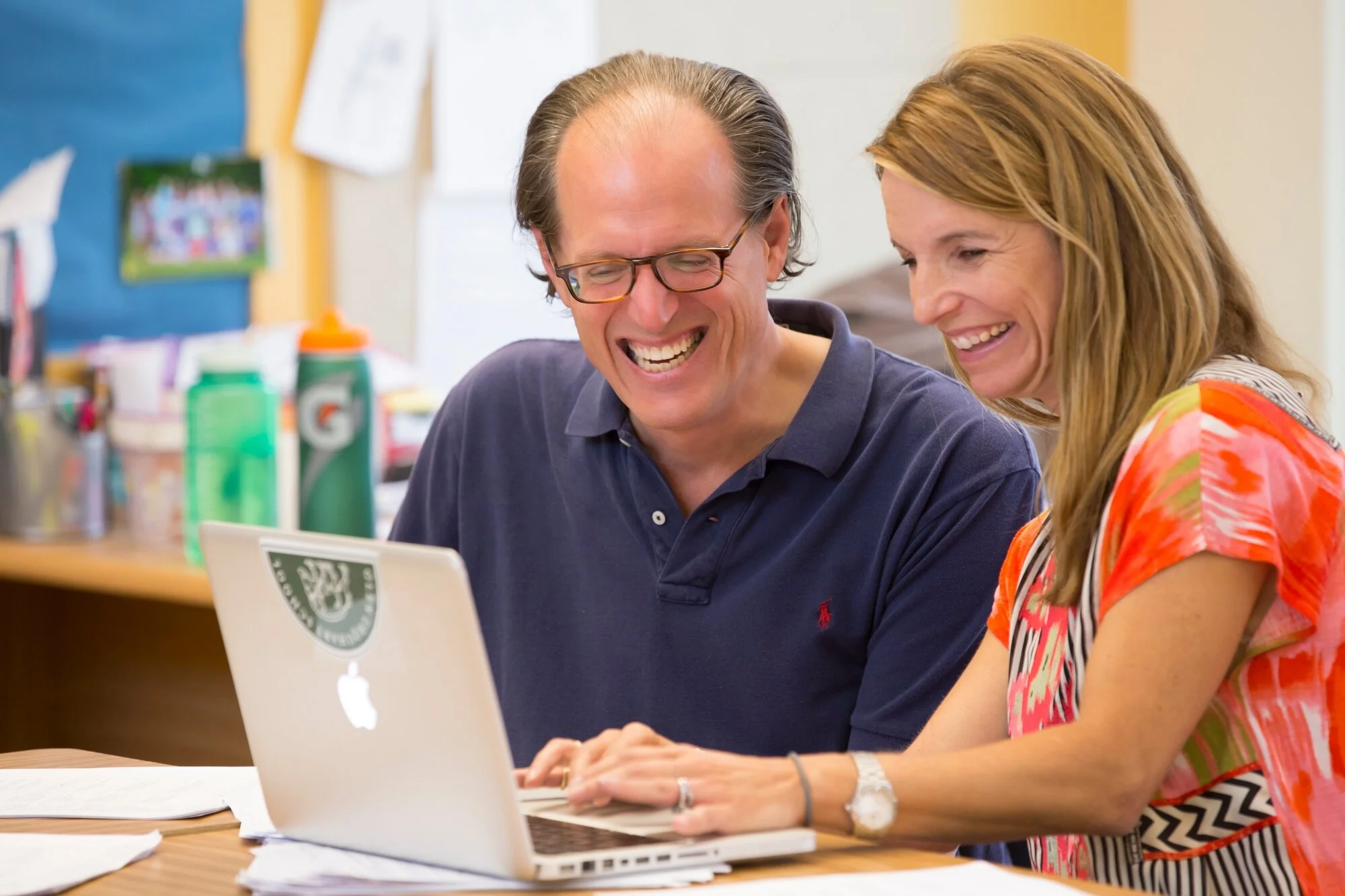The individual:
where do I live + where am I going?
As our 8th graders prepare to move on from GUS, they explore the world, how individual action affects others, and how to make a difference.
Our Curriculum
+ Humanities
Eighth graders turn outward for their final theme and consider “The Individual in Society: Where Do I Live and Where Am I Going?” Just as they did in seventh grade, eighth graders spiral back to revisit these themes, which they first explored in second and third grade, and find opportunities for deeper learning.
In eighth grade, we combine social studies and English in a Humanities curriculum that integrates U.S. history, U.S. and world geography, the immigrant experience, American literature, the influence of politics, and the formation of beliefs. Students begin by studying European immigration to the United States. We take a four-day trip to New York City to visit the Immigration Museum on Ellis Island. While in New York, we also visit the Museum of Modern Art, to prepare for an art project that will occupy the students’ year, and we attend a Broadway play, in anticipation of mounting the eighth grade musical.
Students learn about the early colonies, the Founding Fathers, and the Enlightenment and create a timeline of the influences and events that led to the Revolutionary War. They analyze John Steinbeck’s The Pearl in relation to the concept of the American Dream. They read Harper Lee’s To Kill a Mockingbird and consider what it takes to see through the eyes of another.
As a single team, students design and create a 24 by 18 foot scale map of the United States. Each student is assigned a portion of the country and must determine the appropriate scale and lay out each state using a range of tools, including trigonometry, GPS calculation, and triangulation. Cooperation is vital as classmates negotiate border locations, water boundaries, feature alignments, legend notation, and a myriad of details.
As an aspect of their graduation rites, each eighth grade student writes and delivers a “This I Believe” speech. Students craft these speeches during class time, learning how to construct a speech and how to write for oral presentation, revising and polishing their essays, and practicing before the class.
+ Science
Eighth graders begin their year by considering how scientists collect and measure accurate data to support their findings. They employ various measurement tools: a triple-beam balance, Newton spring scale, digital scale, graduated cylinder, metric ruler, and formulas. They perform a series of experiments to demonstrate the law of conservation of mass, determine the relationship between buoyancy and density, and explore the differences between solutions and mixtures, and they research and create informational brochures detailing the characteristics of the four states of matter. Students learn how scientists identify properties of various substances through chromatography, filtering, evaporation, and fractional distillation. They consider how the periodic table classifies and organizes elements. After studying the structure of the atom, students build a 3-D element model of their own design from objects that represent what that element makes up in the real world. They consider the risks and benefits of radioactivity. In a unit on physics, they review the concepts of force, friction, drag, velocity, speed, acceleration, inertia, and angle of incline and, collaboratively, they design and build large-scale, working Rube Goldberg machines.
+ Mathematics
The eighth grade math curriculum is Algebra I. Students begin the year by considering why variables are used in math. Then they apply properties of multiplication to algebraic equations, specifically, the multiplicative identity property of 1, the property of reciprocals, the multiplication property of zero, the multiplicative property of inequality, and the rate factor model for multiplication. Students learn about polynomials (expressions that contain more than two algebraic terms), how to classify them by degree and number of terms, multiply them, and factor them. They learn to add and subtract algebraic expressions. They also explore these algebraic concepts: linear sentences, slopes and lines, linear systems, exponents and powers, and quadratic expressions.
+ Social/Emotional
In a once-a-week life skills class, students learn skills for healthy decision-making, communication, problem solving, and conflict resolution.
+ Latin
In Latin, eighth graders explore the multiple English derivatives of Latin vocabulary words and begin to realize the centrality of Latin in their own language. For a third year, our emphasis is on parts of speech, vocabulary, noun-adjective agreement, subject-verb agreement, simple composition, and translation. In eighth grade, students complete Ecce Romani IA, the equivalent of first-year Latin. They also engage in several hands-on projects. They learn about Roman slavery and pen a letter home in the character of a slave describing his or her situation. They construct models of Roman roads and land routes. Their study of the Roman political system culminates in a campaign and election. A high point that ends their year is the annual chariot races event. The school band plays trumpet fanfares, teachers don togas to judge the competition, and students race custom-made Roman chariots around our playing fields.
+ Spanish
Eighth grade Spanish students continue to develop communication competence, mastering complex grammatical structures and expanding their vocabulary. The year provides students with valuable opportunities to use those skills in authentic settings: they interview Spanish-speaking immigrants in surrounding communities, they host young visitors from a Central American orphanage, and many travel to that orphanage for their service week trip. As an aspect of all their lessons, we encourage eighth graders to consider how language and culture shape lives, in the United States and beyond. Our classes are conducted almost entirely in Spanish, and we make many interdisciplinary connections: students create art for the school’s El Día de los Muertos altar, they bring science concepts they learned in seventh grade to units on Spanish food and nutrition habits, they use their math skills in units on the metric system and exchange rates. Successful GUS graduates are well qualified to take Spanish II in ninth grade, typically at an advanced level.
+ Visual Arts
Eighth grade art students focus on the self and symbolism. They create a portfolio of pieces that are personal, introspective, and self-revealing, which they share with the school community, along with dance performances, at the annual Arts Block Evening. Working with clay and learning the techniques of relief, incising, carving, wedging, and texturing with ceramic tools, students create “graduate ceramic tiles” decorated with personal symbols that capture their GUS experience. They experiment with water-based materials, such as watercolor paints, Japanese inks, and carandache crayons and create symbolic self-portraits in the manner of Paul Klee. They learn how 60’s Pop Art and 70’s popular culture have influenced our understanding of the role of art in society and politics, and they construct Andy Warhol-styled multiple panel self-portraits. They experiment with encaustic painting and assemble mixed media collages on wood.
The eighth graders undertake one large, long-term project, the White Shirt Project, that challenges their imaginations and skills on many levels. Inspired by their fall trip to the Museum of Modern Art and a unit on contemporary artists and past masters, each student chooses a contemporary artist for this multifaceted exploration. They research the artist, create a conceptual-based biography, and prepare a gallery talk about both the artist’s work and their own. Chiefly, the students engage in an in-depth process of creating an autobiographical mixed-media work that incorporates the white shirt, reflects the style and philosophy of their chosen artist, and contains their original ideas, symbols, and message.
+ Music
Music and drama classes provide exciting opportunities for eighth graders. In preparation for the annual full-scale eighth grade musical production in late spring, students learn stage craft; practice mime, blocking and dance; and work on pitch, blend, diction, and projection.
Of course, once roles are cast, they must learn their music, blocking, choreography, and scripts. Concurrently, they learn audition techniques as well. They learn about how to prepare for auditions, develop stage presence, and deal with performance anxiety.
+ Dance
Eighth grade dance is a project-based student choreography lab that culminates with a dance performance on Arts Block Evening. During their artistic journey students gain an understanding of theme selection and development, creative process, and performance elements.
+ Physical Education
In sports, eighth graders continue to play interscholastic games, choosing the sport they want to play each season. In the fall, they choose between soccer and cross country running; in the winter, they can play basketball or take a fitness class; and in the spring, it’s lacrosse and track. All the teams are made up of both seventh and eighth graders, with the exception of basketball, for which there are grade-level teams, and the teams play a schedule of games each season with other independent schools. After assessing the level of play of each of our teams, our director of athletics works with other schools to schedule games that are good and fair matches. Some years, this means playing other schools’ varsity teams; other years, their junior varsity teams. In upper school sports, everybody plays. There are no tryouts for teams, and no one is cut from a team. We do not give out awards or name team captains; instead, we rotate through game captains.
Our goals are for everyone to have the opportunity to play and for GUS to be competitive with the other schools that we play. And we are! Many of our students go on to play sports in high school and several play at the college level. Students might not play sports after they leave GUS, but they all had the opportunity to participate in sports here.
+ Community Service
As part of their community service, eighth graders volunteer for The Food Project, an organization that delivers more than 60,000 pounds of locally grown produce to community-supported agriculture (CSA) share members, hunger relief organizations, and area farmers markets, by propagating seedlings in the school’s 7,000-square-foot greenhouse. They also volunteer for on-site farm workdays and educational workshops that explore issues related to local and global food systems.
In April, all eighth graders participate in a service week, working either in an international setting (Central America), a national setting (Navajo Nation), or a local setting (community service agencies in the Boston area). Following a tradition begun some 12 years ago, one group works in an orphanage run by NPH, an organization that operates throughout Latin America. Honduras and Costa Rica were past destinations; the Dominican Republic has been the destination for the past three years. The students live and work in a self-sufficient community, interacting with children and volunteering in a variety of capacities. A second group of eighth graders travels within the US to assist with community-based projects. For the past three years, the domestic service trip has been to two Native American semi-autonomous regions—Navajo Nation, in Arizona, and the Lakota Reservation, in South Dakota. In the past, a third group of students has worked locally with community service organizations in the Boston area.

